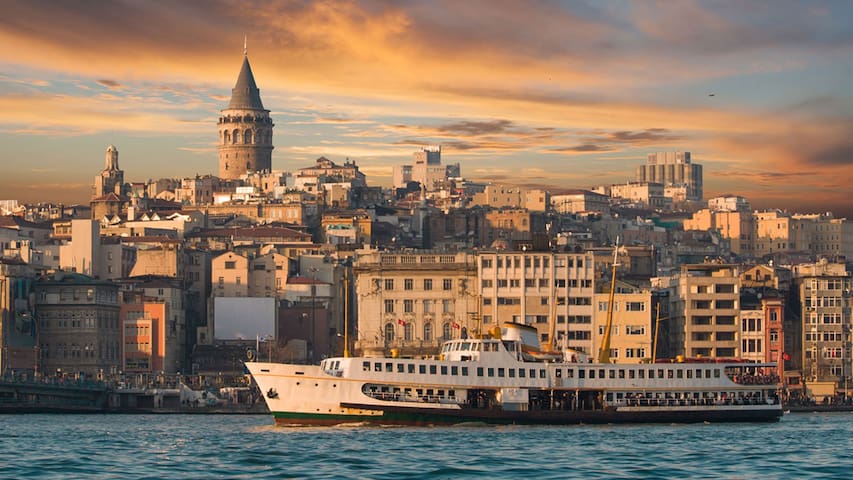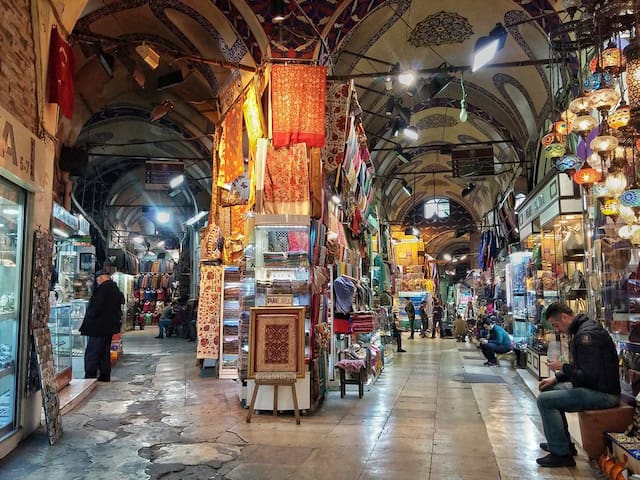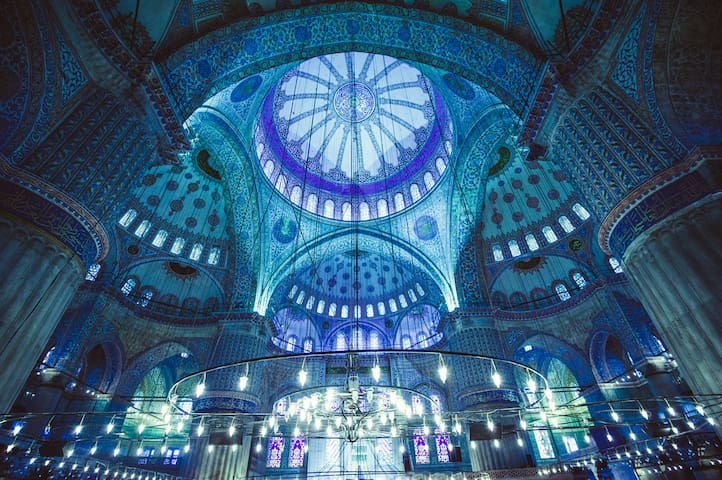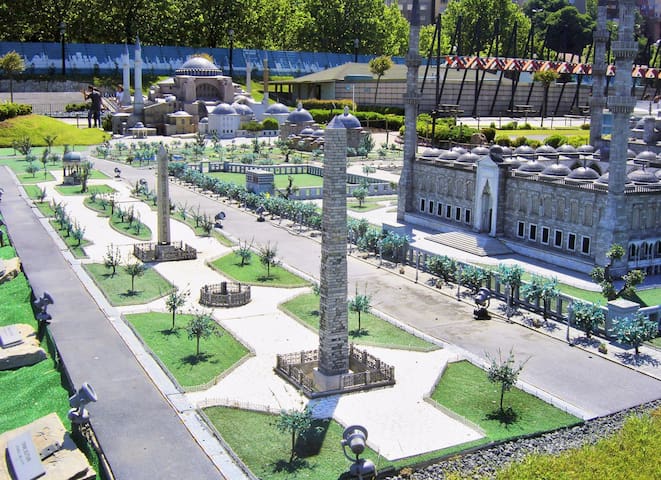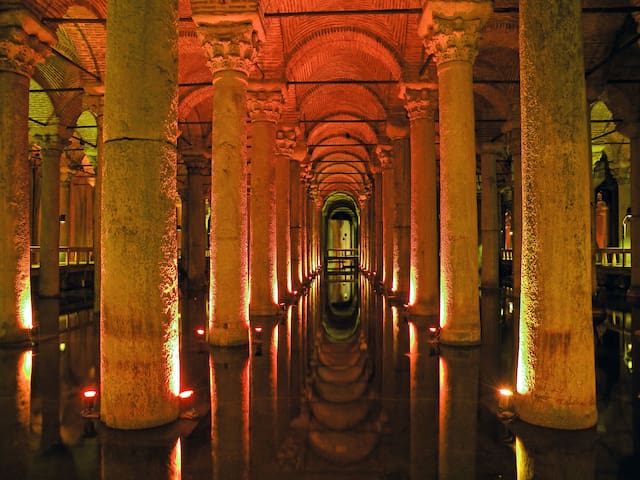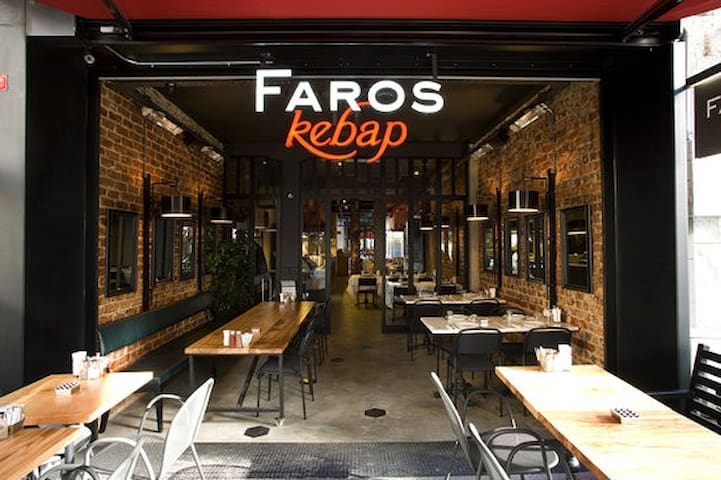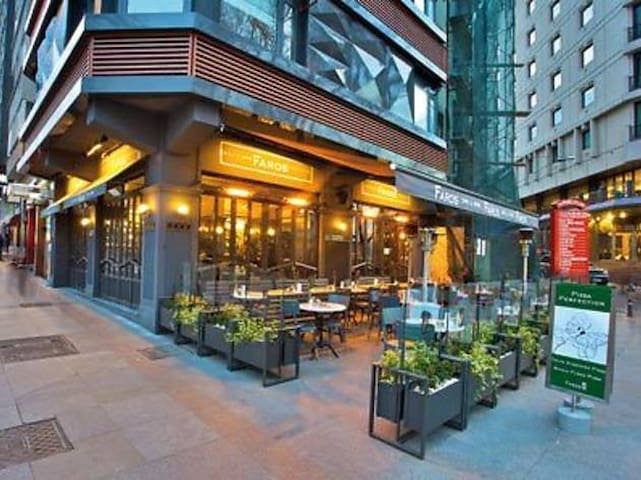Gezilecek yerler
Description from Wikipedia Web Page:
Hagia Sophia (/ˈhɑːɡiə soʊˈfiːə/; from the Greek `Αγία Σοφία, pronounced [haˈʝia soˈfia], "Holy Wisdom"; Latin: Sancta Sophia or Sancta Sapientia; Turkish: Ayasofya) is the former Greek Orthodox Christian patriarchal cathedral, later an Ottoman imperial mosque and now a museum (Ayasofya Müzesi) in Istanbul, Turkey. Built in AD 537 before the Middle Ages, it was famous in particular for its massive dome. It was the world's largest building and an engineering marvel of its time. It is considered the epitome of Byzantine architecture[1] and is said to have "changed the history of architecture".[2]
1014 Recomendado por los habitantes de la zona
Hagia Sophia
No:1 Ayasofya MeydanıDescription from Wikipedia Web Page:
Hagia Sophia (/ˈhɑːɡiə soʊˈfiːə/; from the Greek `Αγία Σοφία, pronounced [haˈʝia soˈfia], "Holy Wisdom"; Latin: Sancta Sophia or Sancta Sapientia; Turkish: Ayasofya) is the former Greek Orthodox Christian patriarchal cathedral, later an Ottoman imperial mosque and now a museum (Ayasofya Müzesi) in Istanbul, Turkey. Built in AD 537 before the Middle Ages, it was famous in particular for its massive dome. It was the world's largest building and an engineering marvel of its time. It is considered the epitome of Byzantine architecture[1] and is said to have "changed the history of architecture".[2]
Wikipedia: Dolmabahçe Palace (Turkish: Dolmabahçe Sarayı, IPA: [doɫmabahˈtʃe saɾaˈjɯ]) located in the Beşiktaş district of Istanbul, Turkey, on the European coast of the Strait of Istanbul, served as the main administrative center of the Ottoman Empire from 1856 to 1887 and from 1909 to 1922 (Yıldız Palace was used in the interim period). Dolmabahçe Palace was ordered by the Empire's 31st Sultan, Abdülmecid I, and built between the years 1843 and 1856. Previously, the Sultan and his family had lived at the Topkapı Palace, but as the medieval Topkapı was lacking in contemporary style, luxury, and comfort, as compared to the palaces of the European monarchs, Abdülmecid decided to build a new modern palace near the site of the former Beşiktaş Sahil Palace, which was demolished. Hacı Said Ağa was responsible for the construction works, while the project was realized by architects Garabet Balyan, his son Nigoğayos Balyan and Evanis Kalfa (members of the Armenian Balyan family of Ottoman court architects).
580 Recomendado por los habitantes de la zona
Dolmabahce Palace
Dolmabahçe CaddesiWikipedia: Dolmabahçe Palace (Turkish: Dolmabahçe Sarayı, IPA: [doɫmabahˈtʃe saɾaˈjɯ]) located in the Beşiktaş district of Istanbul, Turkey, on the European coast of the Strait of Istanbul, served as the main administrative center of the Ottoman Empire from 1856 to 1887 and from 1909 to 1922 (Yıldız Palace was used in the interim period). Dolmabahçe Palace was ordered by the Empire's 31st Sultan, Abdülmecid I, and built between the years 1843 and 1856. Previously, the Sultan and his family had lived at the Topkapı Palace, but as the medieval Topkapı was lacking in contemporary style, luxury, and comfort, as compared to the palaces of the European monarchs, Abdülmecid decided to build a new modern palace near the site of the former Beşiktaş Sahil Palace, which was demolished. Hacı Said Ağa was responsible for the construction works, while the project was realized by architects Garabet Balyan, his son Nigoğayos Balyan and Evanis Kalfa (members of the Armenian Balyan family of Ottoman court architects).
Wikipedia: The Galata Tower (Galata Kulesi in Turkish) — called Christea Turris (the Tower of Christ in Latin) by the Genoese — is a medieval stone tower in the Galata/Karaköy quarter of Istanbul, Turkey, just to the north of the Golden Horn's junction with the Bosphorus. It is a high, cone-capped cylinder that dominates the skyline and offers a panoramic vista of Istanbul's historic peninsula and its environs. The nine-story tower is 66.90 m (219.5 ft) (62.59 m (205.3 ft) without the ornament on top, 51.65 m (169.5 ft) at the observation deck), and was the city's tallest structure when it was built. The elevation at ground level is 61 m (200 ft) above sea-level. The tower has an external diameter of 16.45 m (54.0 ft) at the base, an inside diameter of 8.95 m (29.4 ft), and walls that are 3.75 m (12.3 ft) thick.
There is a restaurant and café on its upper floors which have views of Istanbul and the Bosphorus. Also located on the upper floors is a nightclub which hosts a Turkish show. There are two operating elevators that carry visitors from the lower level to the upper levels.
1235 Recomendado por los habitantes de la zona
Galata Tower
Wikipedia: The Galata Tower (Galata Kulesi in Turkish) — called Christea Turris (the Tower of Christ in Latin) by the Genoese — is a medieval stone tower in the Galata/Karaköy quarter of Istanbul, Turkey, just to the north of the Golden Horn's junction with the Bosphorus. It is a high, cone-capped cylinder that dominates the skyline and offers a panoramic vista of Istanbul's historic peninsula and its environs. The nine-story tower is 66.90 m (219.5 ft) (62.59 m (205.3 ft) without the ornament on top, 51.65 m (169.5 ft) at the observation deck), and was the city's tallest structure when it was built. The elevation at ground level is 61 m (200 ft) above sea-level. The tower has an external diameter of 16.45 m (54.0 ft) at the base, an inside diameter of 8.95 m (29.4 ft), and walls that are 3.75 m (12.3 ft) thick.
There is a restaurant and café on its upper floors which have views of Istanbul and the Bosphorus. Also located on the upper floors is a nightclub which hosts a Turkish show. There are two operating elevators that carry visitors from the lower level to the upper levels.
Wikipedia: The Grand Bazaar (Turkish: Kapalıçarşı, meaning ‘Covered Market’; also Büyük Çarşı, meaning ‘Grand Market’[1]) in Istanbul is one of the largest and oldest covered markets in the world, with 61 covered streets and over 4,000 shops[2][3] on a total area of 30,700 m2[4], attracting between 250,000 and 400,000 visitors daily.[5] In 2014, it was listed No.1 among the world's most-visited tourist attractions with 91,250,000 annual visitors.[6] The Grand Bazaar at Istanbul is often regarded as one of the first shopping malls of the world.
810 Recomendado por los habitantes de la zona
Gran Bazar
Beyazıt CaddesiWikipedia: The Grand Bazaar (Turkish: Kapalıçarşı, meaning ‘Covered Market’; also Büyük Çarşı, meaning ‘Grand Market’[1]) in Istanbul is one of the largest and oldest covered markets in the world, with 61 covered streets and over 4,000 shops[2][3] on a total area of 30,700 m2[4], attracting between 250,000 and 400,000 visitors daily.[5] In 2014, it was listed No.1 among the world's most-visited tourist attractions with 91,250,000 annual visitors.[6] The Grand Bazaar at Istanbul is often regarded as one of the first shopping malls of the world.
Wikipedia: The Süleymaniye Mosque (Turkish: Süleymaniye Camii, Turkish pronunciation: [sylejˈmaːnije]) is an Ottoman imperial mosque located on the Third Hill of Istanbul, Turkey. The mosque was commissioned by Suleiman the Magnificent and designed by the imperial architect Mimar Sinan. An inscription specifies the foundation date as 1550 and the inauguration date as 1557. The mosque was built by the Ottoman sultan Suleyman (r. 1520-1566) and the mosque was named after him. The mosque is located at the highest end of the city of Istanbul. It is designed to glorify the sultan[1] Construction of this mosque began before 1550 and was nearly completed in 1557[2]. Sultan Suleyman used Mimar Sinan (d. 1588), the greatest engineer and architect of his time for the work of this mosque [3]. The architecture and craftsmanship of the mosque are very beautiful and attract many worshipers and visitors.
The Süleymaniye Mosque, was built on the order of Sultan Süleyman (Süleyman the Magnificent), and designed by the imperial architect Mimar Sinan. The Arabic foundation inscription above the north portal of the mosque is carved in thuluth script on three marble panels. It gives a foundation date of 1550 and an inauguration date of 1557. In reality the planning of the mosque began before 1550 and parts of the complex were not completed until after 1557.[4]
The design of the Süleymaniye also plays on Suleyman's self-conscious representation of himself as a 'second Solomon.' It references the Dome of the Rock, which was built on the site of the Temple of Solomon, as well as Justinian's boast upon the completion of the Hagia Sophia: "Solomon, I have surpassed thee!"[5] The Süleymaniye, similar in magnificence to the preceding structures, asserts Suleyman's historical importance. The structure is nevertheless smaller in size than its older archetype, the Hagia Sophia.
211 Recomendado por los habitantes de la zona
Mezquita de Suleymaniye
No:1 Prof. Sıddık Sami Onar Cd.Wikipedia: The Süleymaniye Mosque (Turkish: Süleymaniye Camii, Turkish pronunciation: [sylejˈmaːnije]) is an Ottoman imperial mosque located on the Third Hill of Istanbul, Turkey. The mosque was commissioned by Suleiman the Magnificent and designed by the imperial architect Mimar Sinan. An inscription specifies the foundation date as 1550 and the inauguration date as 1557. The mosque was built by the Ottoman sultan Suleyman (r. 1520-1566) and the mosque was named after him. The mosque is located at the highest end of the city of Istanbul. It is designed to glorify the sultan[1] Construction of this mosque began before 1550 and was nearly completed in 1557[2]. Sultan Suleyman used Mimar Sinan (d. 1588), the greatest engineer and architect of his time for the work of this mosque [3]. The architecture and craftsmanship of the mosque are very beautiful and attract many worshipers and visitors.
The Süleymaniye Mosque, was built on the order of Sultan Süleyman (Süleyman the Magnificent), and designed by the imperial architect Mimar Sinan. The Arabic foundation inscription above the north portal of the mosque is carved in thuluth script on three marble panels. It gives a foundation date of 1550 and an inauguration date of 1557. In reality the planning of the mosque began before 1550 and parts of the complex were not completed until after 1557.[4]
The design of the Süleymaniye also plays on Suleyman's self-conscious representation of himself as a 'second Solomon.' It references the Dome of the Rock, which was built on the site of the Temple of Solomon, as well as Justinian's boast upon the completion of the Hagia Sophia: "Solomon, I have surpassed thee!"[5] The Süleymaniye, similar in magnificence to the preceding structures, asserts Suleyman's historical importance. The structure is nevertheless smaller in size than its older archetype, the Hagia Sophia.
Wikipedia: Sultan Ahmed Mosque (Turkish: Sultan Ahmet Camii; also known as the Blue Mosque) is a historic mosque located in Istanbul, Turkey. It remains a functioning mosque, while also attracting large numbers of tourist visitors. It was constructed between 1609 and 1616 during the rule of Ahmed I. Its Külliye contains Ahmed's tomb, a madrasah and a hospice. Hand-painted blue tiles adorn the mosque’s interior walls, and at night the mosque is bathed in blue as lights frame the mosque’s five main domes, six minarets and eight secondary domes.[2] It sits next to the Hagia Sophia, another popular tourist site.
After the Peace of Zsitvatorok and the crushing loss in the 1603–18 war with Persia, Sultan Ahmet I decided to build a large mosque in Istanbul to reassert Ottoman power. It would be the first imperial mosque for more than forty years. While his predecessors had paid for their mosques with the spoils of war, Ahmet I procured funds from the Treasury, because he had not gained remarkable victories. The construction was started in 1609 and not completed until 1616.[3]
It caused the anger of the ulama, the Muslim jurists. The mosque was built on the site of the palace of the Byzantine emperors, in front of the basilica Hagia Sophia (at that time, the primary imperial mosque in Istanbul) and the hippodrome, a site of significant symbolic meaning as it dominated the city skyline from the south. Big parts of the south shore of the mosque rest on the foundations, the vaults of the old Grand Palace.[4]
803 Recomendado por los habitantes de la zona
Mezquita Azul
No:10 Atmeydanı Cd.Wikipedia: Sultan Ahmed Mosque (Turkish: Sultan Ahmet Camii; also known as the Blue Mosque) is a historic mosque located in Istanbul, Turkey. It remains a functioning mosque, while also attracting large numbers of tourist visitors. It was constructed between 1609 and 1616 during the rule of Ahmed I. Its Külliye contains Ahmed's tomb, a madrasah and a hospice. Hand-painted blue tiles adorn the mosque’s interior walls, and at night the mosque is bathed in blue as lights frame the mosque’s five main domes, six minarets and eight secondary domes.[2] It sits next to the Hagia Sophia, another popular tourist site.
After the Peace of Zsitvatorok and the crushing loss in the 1603–18 war with Persia, Sultan Ahmet I decided to build a large mosque in Istanbul to reassert Ottoman power. It would be the first imperial mosque for more than forty years. While his predecessors had paid for their mosques with the spoils of war, Ahmet I procured funds from the Treasury, because he had not gained remarkable victories. The construction was started in 1609 and not completed until 1616.[3]
It caused the anger of the ulama, the Muslim jurists. The mosque was built on the site of the palace of the Byzantine emperors, in front of the basilica Hagia Sophia (at that time, the primary imperial mosque in Istanbul) and the hippodrome, a site of significant symbolic meaning as it dominated the city skyline from the south. Big parts of the south shore of the mosque rest on the foundations, the vaults of the old Grand Palace.[4]
Plaza del Sultán Ahmet
No:2 Sultan Ahmet ParkıWikipedia: The Topkapı Palace (Turkish: Topkapı Sarayı[2], meaning Cannon Gate Palace or in Ottoman Turkish: طوپقپو سرايى, Ṭopḳapu Sarāyı),[3] or the Seraglio,[4] is a large museum in the east of the Fatih district of Istanbul in Turkey. In the 15th and 16th centuries it served as the main residence and administrative headquarters of the Ottoman sultans.
Construction, ordered by the Sultan Mehmed the Conqueror, began in 1459, six years after the conquest of Constantinople. Topkapı was originally called the "New Palace" (Yeni Saray or Saray-ı Cedîd-i Âmire) to distinguish it from the Old Palace [tr] in Beyazıt Square. It was given[by whom?] the name Topkapı, meaning Cannon Gate, in the 19th century.[5] The complex expanded over the centuries, with major renovations after the 1509 earthquake and the 1665 fire. The palace complex consists of four main courtyards and many smaller buildings. Female members of the Sultan's family lived in the harem, and leading state officials, including the Grand Vizier, held meetings in the Imperial Council building.
After the 17th century, Topkapı gradually lost its importance. The sultans of that period preferred to spend more time in their new palaces along the Bosphorus. In 1856 Sultan Abdulmejid I decided to move the court to the newly built Dolmabahçe Palace. Topkapı retained some of its functions, including the imperial treasury, library and mint.
After the end of the Ottoman Empire in 1923, a government decree dated April 3, 1924 transformed Topkapı into a museum. Turkey's Ministry of Culture and Tourism now administers the Topkapı Palace Museum. The palace complex has hundreds of rooms and chambers, but only the most important are accessible to the public as of 2020, including the Ottoman Imperial Harem and the treasury, called hazine where the Spoonmaker's Diamond and the Topkapi Dagger are on display. The museum collection also includes Ottoman clothing, weapons, armor, miniatures, religious relics, and illuminated manuscripts such as the Topkapi manuscript. Officials of the ministry as well as armed guards of the Turkish military guard the complex. The Topkapı Palace forms a part the Historic Areas of Istanbul, a group of sites in Istanbul that UNESCO recognised as a World Heritage Site in 1985.[6]
717 Recomendado por los habitantes de la zona
Topkapi Palace
Wikipedia: The Topkapı Palace (Turkish: Topkapı Sarayı[2], meaning Cannon Gate Palace or in Ottoman Turkish: طوپقپو سرايى, Ṭopḳapu Sarāyı),[3] or the Seraglio,[4] is a large museum in the east of the Fatih district of Istanbul in Turkey. In the 15th and 16th centuries it served as the main residence and administrative headquarters of the Ottoman sultans.
Construction, ordered by the Sultan Mehmed the Conqueror, began in 1459, six years after the conquest of Constantinople. Topkapı was originally called the "New Palace" (Yeni Saray or Saray-ı Cedîd-i Âmire) to distinguish it from the Old Palace [tr] in Beyazıt Square. It was given[by whom?] the name Topkapı, meaning Cannon Gate, in the 19th century.[5] The complex expanded over the centuries, with major renovations after the 1509 earthquake and the 1665 fire. The palace complex consists of four main courtyards and many smaller buildings. Female members of the Sultan's family lived in the harem, and leading state officials, including the Grand Vizier, held meetings in the Imperial Council building.
After the 17th century, Topkapı gradually lost its importance. The sultans of that period preferred to spend more time in their new palaces along the Bosphorus. In 1856 Sultan Abdulmejid I decided to move the court to the newly built Dolmabahçe Palace. Topkapı retained some of its functions, including the imperial treasury, library and mint.
After the end of the Ottoman Empire in 1923, a government decree dated April 3, 1924 transformed Topkapı into a museum. Turkey's Ministry of Culture and Tourism now administers the Topkapı Palace Museum. The palace complex has hundreds of rooms and chambers, but only the most important are accessible to the public as of 2020, including the Ottoman Imperial Harem and the treasury, called hazine where the Spoonmaker's Diamond and the Topkapi Dagger are on display. The museum collection also includes Ottoman clothing, weapons, armor, miniatures, religious relics, and illuminated manuscripts such as the Topkapi manuscript. Officials of the ministry as well as armed guards of the Turkish military guard the complex. The Topkapı Palace forms a part the Historic Areas of Istanbul, a group of sites in Istanbul that UNESCO recognised as a World Heritage Site in 1985.[6]
Taksim Square
Cisterna Basílica
1/3 Yerebatan Cd.Yemek ortamı
Faros Kebap
28 Şht. Muhtar Bey CaddesiFaros Kebap Taksim
Faros Dine & Wine
No:31 Cumhuriyet Cd.Faros Dine & Wine Taksim
Batard istanbul
15D Silahşör Cd.Batard Istanbul


